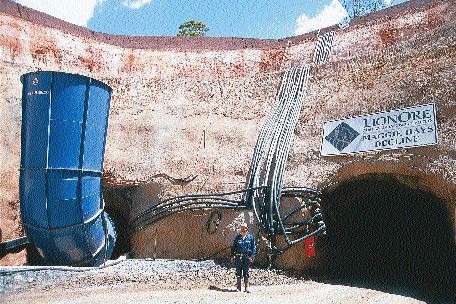Perth, Western Australia — Australia has been good for
The company set up a beachhead Down Under after Australian-based
The story was of the troubled Bounty gold mine and of the emerging sulphide nickel belt at nearby Lake Johnston, west of the gold mining town of Norseman in Western Australia.
The Canadians took the bait. And as attention began to focus on Lake Johnston, they backed corporate manoeuvres for project consolidations and chose one of Forrestania’s emissaries, Mark Ashley, to head the company’s Australian operations.
Ashley, a Brit, had graduated from both the Algy Cluff entrepreneurial school, which produced gold, diamond and oil companies in the North Sea, Zimbabwe and Australia, and the empire-building school of Robert Champion de Crespigny, who developed
Through the acquisitions and mergers to secure control of the belt containing the Emily Ann and Maggie Hays nickel deposits, LionOre set up a listed Australian subsidiary but later re-consolidated.
Ashley, whose financial skills have been noted in the West Perth mining community, which houses a large proportion of the country’s explorers and miners, was able to piece together a team of skilled explorers, miners, and now, mineral processors.
From a relatively short genesis, LionOre has become Australia’s second-largest nickel producer, and its progress in the past three years has surpassed that of the country’s producers of lateritic nickel-cobalt.
That may change in a few years when
Nevertheless, LionOre is virtually assured of remaining one of the top 10 nickel producers. Annual production stands at 30,000 tonnes nickel, and there is scope for growth in both Western Australia and southern Africa. The projection is that the company — listed in Toronto, Australia, London and Botswana — will achieve group production in 2008 of 80,000 tonnes nickel.
The Australian subsidiary’s growing nickel empire has the Emily Ann and Maggie Hays mines, at Lake Johnston, the 80%-owned Silver Swan-Black Swan operation, north of Kalgoorlie, and the Waterloo project, in the Leinster belt. And farther north, the big Honeymoon Well project is taking shape.
Cash also flows from the Thunderbox gold mine in the Leinster belt. Thunderbox was a LionOre discovery in partnership with
LionOre is a nickel producer and Thunderbox is essentially an aside, albeit a healthy one, producing 160,000 oz. gold per year at manageable cash costs. Observers say LionOre is not getting good market value for what is considered one of Australia’s best-performing gold operations.
The path forward will be determined by technology. Six years ago, LionOre bought the emerging Activox hydrometallurgical process from Dominion Mining and set up Western Mineral Technology with Gary Johnson, who is a 20% stakeholder.
Activox can treat a wide range of nickel sulphide concentrates to produce nickel metal. Advanced tests indicate it is ideal for deposits that have contaminants such as talc and arsenic. A demonstration plant will be built at the Phoenix mine in Botswana. The government of Botswana is a 15% partner in the mine, which is held by LionOre subsidiary Tati Nickel. If all goes according to plan, Phoenix will be producing 17,000-19,000 tonnes of nickel cathode per year, as well as copper cathode and an intermediate cobalt product.
LionOre expanded its presence in Africa by acquiring a half-interest in the Nkomati nickel project, 300 km east of Johannesburg, from
Many companies are now considering the applicability of Activox.
Ashley says that in addition to bypassing conventional smelting, Activox is tailor-made for deposits with impurities that are rejected by smelters.
One of LionOre’s smartest acquisitions was the old Bulong lateritic nickel-cobalt project, near Kalgoorlie. The company paid a mere $15 million for a project that cost A$300 million to put together in the mid-1990 (before it collapsed and became a problem for Barclays Bank).
The centre-piece of this elaborate complex is an autoclave and pressure-oxidation network, which will be converted from treating laterites to sulphide ore and which will have Activox engineered into the mineral processing assembly line.
Ashley says the hydrometallurgical process for sulphide ores require less than half the heating requirements of the titanium-metal autoclave.
Renamed Avalon, the Bulong complex could well prove to be a metallurgical Camelot for LionOre, not only boosting group production capacity but allowing new joint ventures to be developed.
One example is Australia’s
LionOre has a market capitalization of $A1.4 billion and more than US$200 million in cash.
— The author is a freelance writer based in Perth, Western Australia.


Be the first to comment on "LionOre’s growing Australian presence"